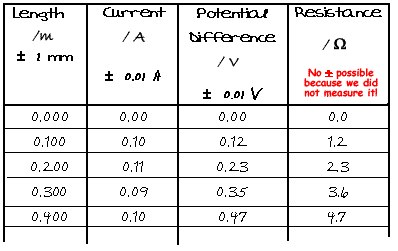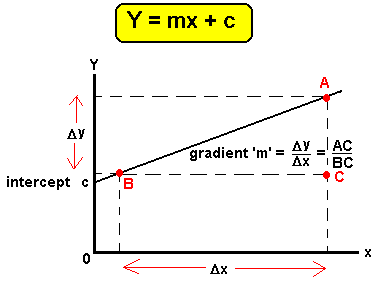|
This information was extracted
from a circular sent out by the AQA examining board January 2001
It has been amended, added
to and illustrated by Mrs. Jones (May 2001/October 2001)

Intra-document hyperlinks:
Accuracy and Precision
Dealing with errors
Presenting
Results in a table
Significant
Figures
Using Graphs
Presenting
Results in a table
Tables
should always be used to present results.
There
should be a column for
 each
set of readings taken (never omit these!) each
set of readings taken (never omit these!)
 each
set of calculated values from the experimental data (these may be derived for
you to calculate values or plot a graph) each
set of calculated values from the experimental data (these may be derived for
you to calculate values or plot a graph)
Headings should
 be at
the top of a column of numbers (this is preferable to on the left of a series
of results). be at
the top of a column of numbers (this is preferable to on the left of a series
of results).
 give the physical quantity measured in words (eg. current, potential difference,
length, time) . Abbeviations (I,
V, l, t) can be used only if it is clear what they stand for in the text - it
is best to include both! give the physical quantity measured in words (eg. current, potential difference,
length, time) . Abbeviations (I,
V, l, t) can be used only if it is clear what they stand for in the text - it
is best to include both!
 include the unit the physical property is measured in. This should preferably
be the S.I. unit (as this is the one that will be required in calculations).e.g.
Current I (A) include the unit the physical property is measured in. This should preferably
be the S.I. unit (as this is the one that will be required in calculations).e.g.
Current I (A)
 have an
indication of the error involved in taking the reading (if applicable). This can
be given as a + value or percentage have an
indication of the error involved in taking the reading (if applicable). This can
be given as a + value or percentage
 have
border lines drawn around them. have
border lines drawn around them.
Columns should
 contain
only numerals (Your units are at the top already.... it would be a mistake to
put them in again!) contain
only numerals (Your units are at the top already.... it would be a mistake to
put them in again!)
 contain
numbers to the correct number of significant figures. This should indicate the
accuracy to which you can read the instruments you have used. (e.g. 0.20 m indicates
a reading taken to the nearest cm whereas 0.2 cm indicates you can only read to
the nearest 10 cm and 0.200 m to the nearest mm). Therefore a column representing
a set of readings taken with the same instrument should all have the same number
of significant figures. contain
numbers to the correct number of significant figures. This should indicate the
accuracy to which you can read the instruments you have used. (e.g. 0.20 m indicates
a reading taken to the nearest cm whereas 0.2 cm indicates you can only read to
the nearest 10 cm and 0.200 m to the nearest mm). Therefore a column representing
a set of readings taken with the same instrument should all have the same number
of significant figures.
 have
border lines drawn around them have
border lines drawn around them

Word-processing of results can lead to errors. You should be very careful to check your final draft
carefully if you word process a report!
Common
errors that lose you marks:
 Using
the wrong font: remember the symbol allows you to put in greek letters such as W, n, and m. Using
the wrong font: remember the symbol allows you to put in greek letters such as W, n, and m.
 Entering
numbers to the wrong number of significant figures (especially if worked out
on a spreadsheet without thought to formatting the numbers in the column). Entering
numbers to the wrong number of significant figures (especially if worked out
on a spreadsheet without thought to formatting the numbers in the column).
 Missing
out the columns for 'readings taken' - only including columns needed to calculate
the conclusion value or plot a graph is a major error - you must include the columns
of results you took during the experiment! Missing
out the columns for 'readings taken' - only including columns needed to calculate
the conclusion value or plot a graph is a major error - you must include the columns
of results you took during the experiment!
 Incorrectly
calculated derived values because you have put the wrong formula into your spreadsheet - always check
at least two values in a 'fill down' column with your calculator! Incorrectly
calculated derived values because you have put the wrong formula into your spreadsheet - always check
at least two values in a 'fill down' column with your calculator!
 Not
drawing a border - making it a list of numbers not a table of results. Not
drawing a border - making it a list of numbers not a table of results.
Significant
Figures
In experimental physics significant
figures in a number refers to all the figures obtained by direct measurement,
excluding any zeros which are used only to place the decimal point.
e.g.
|
Measured
value
|
Significant
figures
|
|
5
|
1
|
|
5.00
|
3
|
|
0.123
|
3
|
|
3.1415 x 103
|
5
|
When
numbers are used in calculations then the number of significant figures in the
answer should be found by using an analysis of error measurements. This is because
the last significant figure tells the reader to what precision you are recording
the value.
e.g.
|
Recorded result
|
Implied precision
|
|
7
|
implies
that the value is between 6.5 and 7.5 the precision is 0.5 / 7 or 7% |
|
7.00
|
implies
that the value is between 6.995 and 7.005 the precision is 0.005 / 7.00 or 0.07
% |
Therefore
if we have values of 0.96 and 1.25 which are to be multiplied we are claiming
the precision of each number is ;
0.5 %
for 0.96 0.4% for 1.25
Hence 0.96 x 1.25
= 1.2 but this implies a precision of 4% and therefore we would be better to
write 1.20.
As a general rule when multiplying
or dividing numbers express your answer to the same number of significant
figures as the least precise figure.
e.g.
(i) 2.4 x 33.5 = 80.4
least precise figure
is 2.4 with 2 significant figures and hence we write the answer as 80
e.g. (ii)
18.5 - 0.9300 = 19.892473
least precise
figure is 18.5 with 3 significant figures and hence we write the answer as 19.9
(notice that when the answer is rounded off to three significant figures if the
fourth figure is five or greater the third would increase by 1 but if it were
four or less then it would stay the same).
Accuracy
and Precision
As with many ideas in
science accuracy and precision often cause problems not because they are difficult
to understand but because they have 'everyday' and 'scientific' meanings. You
need to have a scientific understanding of the two terms if you are to gain maximum
credit for your work.
Accuracy
This refers to results that are close to the 'actual
value'. We say that the systematic error is very small.
Precision
This refers to the spread of repeated results.
We say that the random error is very small if they are close to each other
Does one imply the other?
Simply
put the answer to that must be 'no' since data can be:-
- accurate and precise
- inaccurate and precise
- accurate and imprecise
- inaccurate and imprecise
e.g.
1. Measuring the diameter of a sphere to be used in a terminal velocity investigation.
If the true value of the diameter is 1.00 cm and you use a micrometer reading
to 0.0005 cm then the precision would be ± 0.05%. However if the micrometer
has a large zero error then the data would be inaccurate.
e.g.
2. If you measure the diameter of the same sphere but this time use a metre
rule
calibrated in mm you could estimate
to the nearest 0.5 mm which gives a precision of ± 5%. However you are
likely to have a mean value which is very close to the actual value which makes
the data accurate.
Dealing
with Errors
Errors
in a single measurement
Errors
in a large number of measurements of the same quantity
Errors
in derived data
Adding
or subtracting quantities
Multiplying
or dividing quantities
Raising
a number to a power
Here
we are dealing with the quantifiable errors, either random or systematic, which occur during any experimental
work. These errors are not to be confused with mistakes. For example,
a badly plotted point on a graph or a transcription error when taking data from
one table to another is a mistake NOT an error.
Errors
in a single measurement
Imagine
that some sort of super being was capable of measuring the diameter of a disc
as 10.34526765867m. If you or I try to measure the diameter of the same disc,
we are limited by our ability to read the instrument being used and the smallest
division on that instrument. If we record the diameter to be 10.345m we are saying
that it lies between 10.344 5m and 10.3455m that is an error of ±0.000
5m.
The value would then be recorded
as 10.345 ± 0.0005 m.
Errors
in a large number of measurements of the same quantity
When
a number of repeat readings are taken then fluctuations due to the ability of
the observer and the limitation of the apparatus can be shown and an estimation
of the error made.
Imagine that
the following measurements were made for the diameter of a wire with a standard
wire gauge of 36.
0.220mm, 0.201mm.
0.190mm. 0.190mm, 0.190mm. 0.191mm. 0.190mm. 0.200mm. 0.191mm. 0.195mm.
First find the mean value, add up all
the values and divide by the number of values, this gives a value of 0.1958mm.
To calculate the error we need to calculate
the absolute, i.e. ignore any negative signs, difference between the mean value
and each individual value. This is the deviation from the mean and the error estimate
is the mean of these deviations. A spreadsheet can easily be set up to do this
for you.
For our values we get a mean deviation
of 0.006720. Since this value is an estimation it is a good idea to keep a careful
eye on the number of significant figures. In this instance the value would be
best recorded as;
0.1958 ±
0.0067 mm
Errors
in derived data
Adding
or subtracting quantities
Multiplying
or dividing quantities
Raising
a number to a power
Once
readings have been recorded they are usually put into some formula or equation
to generate what is called derived data. We cannot know if the error in the individual
quantities are going to cancel each other or compound each other. To be sure we
take the more pessimistic of the two. To calculate these errors simple formulae
can be used.
Adding
or subtracting quantities
When
adding or subtracting quantities the combined error is found by adding the absolute error.
If c = a + b or c
= a - b and the absolute errors in a and b are ± =Δa and ±Δb
then Δc = Δa + Δb where Δc
is the absolute error in c
e.g. The four
sides of a soccer pitch are measured to be 75.1m. 75.9m, 33.2m and 33.7m each
with an error of ± 0.1 m. The perimeter of the pitch is then 217.9 ±
0.4m
Multiplying
or dividing quantities
When multiplying
or dividing quantities the combined error is found by adding the percentage
or fractional error.
If
c = a x b or c = a/b and the percentage errors in a and b are ± Da/a and ± Db/bthen Dc/c = Da/a
+ Db/b where Dc/c
is the percentage error in from which Dc
the absolute error in c can be calculated. e.g.
A
current of 5.0 A which is read to a precision of ± 0.1A flows through a
resistor of nominal value 1000. The resistor is said to be accurate to ±
10%. The potential difference across the resistor would be found by;
V = I x R
V
= 5.0 x 100 volts
= 500 volts
The percentage error in the value of V would be found by
DV
/ V= DI /I + DR / R
DV / 500 =0.1 /
5+ 10 / 100
\ DV=60
volts
Therefore we record
V = 500 + 60 V as the final answer
Raising
a number to a power
If we raise
a number to a power it is a special case of multiplying a number by itself and
you can easily show that if the percentage error in z is ± Dz
/ z then the error in z2 is ± 2Dz
/z. In general we can say that if the percentage error in z is ± Dz
then the percentage error in zn is nDz
/ z where n is a positive number.
e.g. If the
mean value for the diameter, d, of a wire is 0.194 ± 0.004mm then the
cross-sectional area, A can be found from:
A = pd2 / 4
A = (3.142 x O.1942 ) /4 = 0.0296 mm2
The easiest
way to work out the error is to work out the max and min of the value…
MAX diameter
is 0.198 mm
Therefore A(max) is 0.0308 mm2
Similarly MIN diameter is 0.190 mm
Therefore A(min) is 0.0284 mm2
Error is
therefore +0.0012 mm2
So the percentage
error is (0.0012/0.0296) x 100 = 4.1%
Alternatively
you can argue that:
The percentage
error in A is equal to the percentage error in d2
Dd2 /d = 2Dd /d (two lots because it is squared!) = 2
x 0.004 / 0.194 = 0.0412
= 0.0412 x 100% = 4.12%
Therefore
A / A = 0.0412
Which gives A (the absolute error in A) = 0.0012 mm2
Therefore
we record A = 0.0296 ± 0.0012 mm2
Using
Graphs
Dealing
with Errors when Using Graphs
Gradient
of a straight line
Gradient
of a curve
Intercept
Plotting graphs
Relationships involving powers
Straight line graphThe
straight line graph

The general form of a linear
equation is y = mx + c in which y is taken to be the dependent and x the
independent variable; this is the one that you vary. with m and c being constants. The gradient of the line. which may be negative, gives the value
of m whilst the intercept on the vertical axis gives the value of c.
A graph is used to summarise data in
a pictorial way such that the main features of the relationship under investigation
can be seen. Since linear relationships are easier to 'see' the straight line
graph is of great importance in physics.
Plotting
graphs
In order to extract
the maximum of reliable data from a graph it is important to make full use of
the graph paper,
a. Whenever
it is available make use of 1mm A4 graph paper but in all case use A4 graph paper
b. When choosing a scale for the graph
ensure your data covers at least 8cm by 8cm on that scale
c.
When finding the gradient make sure that you use the largest possible values for
Δx and Δy.
d. Include error
bars and / or least and greatest gradient lines
e. Do not forget the units for m and c
The
intercept
For an equation
of the form y = mx + c when x = 0 then y must be equal to c
WARNING!
If
the x-axis does not start at x = 0
then
the intercept on the y-axis WILL NOT give the value of c.
Sometimes
in order to generate a more sensible scale it is better not to start at x = 0
but the above warning must then be remembered. The y-axis does not, however, need
to start at y = 0 in order to obtain the value of c from the intercept
The
gradient
If we consider the
equation y = mx + c then we can transpose to give;
m =(y-c) / x
You
should also notice that the gradient is given by
change in gradient = change in y value change in x value
OR
gradient = Dy/Dx
Relationships
involving powers
Not all
of the relationships you investigate will be linear in nature, many will be of
the form y = kxn where k and n are constants. Plotting a graph
of y and x would produce a curve which would not allow k or n to be found.
This can be resolved be the use of logs.
y = kxn
log y = log k + n (log x)
or
log y= n log x+ log k
this
is now in the form of
y =mx +
c
So,
if you now plot log y on the vertical axis and log x on the horizontal a straight
line will be produced which will allow 'n' to be found from the gradient and log
k to be found from the intercept. This, in turn, allows k to be found.
When you plot a log graph the log values
need to be tabulated; note that log values do not have units.
|
P.D. (V)
|
log(P.D./V)*
|
current
(A)
|
log(current/A)*
|
|
20.0
|
1.30
|
0.60
|
- 0.22**
|
|
40.0
|
1.60
|
1.6
|
0.20
|
|
60.0
|
1.78
|
3.3
|
0.52
|
|
80.0
|
1.90
|
4.9
|
0.69
|
|
100
|
2.00
|
6.5
|
0.81
|
* use a sensible number of significant figures
- you have got to plot the data later.
**
take care - log values can be negative
The
gradient of a curve
Rather than draw
a log graph to turn a curve into a straight line it is sometimes useful to use a curve in order to more readily see the trend of the results. Information
is sometimes required that means finding the gradient of the curve at a given
point. This is done by drawing a tangent to the curve at that point A tangent
only touches the curve at that one point and is said to be 'perpendicular to the
normal of the curve at that point'
Drawing
tangents is often utilised in work involving varying rates.
Dealing
with Errors when Using Graphs
When
a graph of the form y = mx + c is plotted it produces a straight line.
The gradient of such a graph is m and the intercept c. These values are
often the quantities we are trying to find in our investigation and as such some
estimation of the error in them needs to be made.
The
best fit line is used to give a measurement of the gradient and intercept. This
must be shown in your coursework. However if we wish to estimate the error then
we can draw the two additional lines -one the steepest possible through the points and one at the shallowest gradient. The gradient of the steeper
of the two is called Mmax and the other Mmin.
The
error in the value of m can be estimated as Dm = (Mmax - Mmin )/2 Therefore the value quoted for the gradient is m ±Dm
The error in the intercept can be treated
in the same way giving Dc
= (cmax - cmin )/2
Hence
this value is recorded as c ± D c
Obviously you need to keep a careful eye on
the number of significant figures used and also try to make sure that you
don't include any points which are known to be in error, If a point seems
to be too far away from the trend shown by the others either go back and check
it or consider leaving it out. If you leave it out of your graph you should still
record it in your results table and comment on why you have omitted it from the
graph.
The
values for the quantities on the x and y axes will have an error associated
with them and this can be shown on the graph by the use of error bars. Rather
than simply plotting a point lines are added to show the error range.
|









 each
set of readings taken (never omit these!)
each
set of readings taken (never omit these!)

